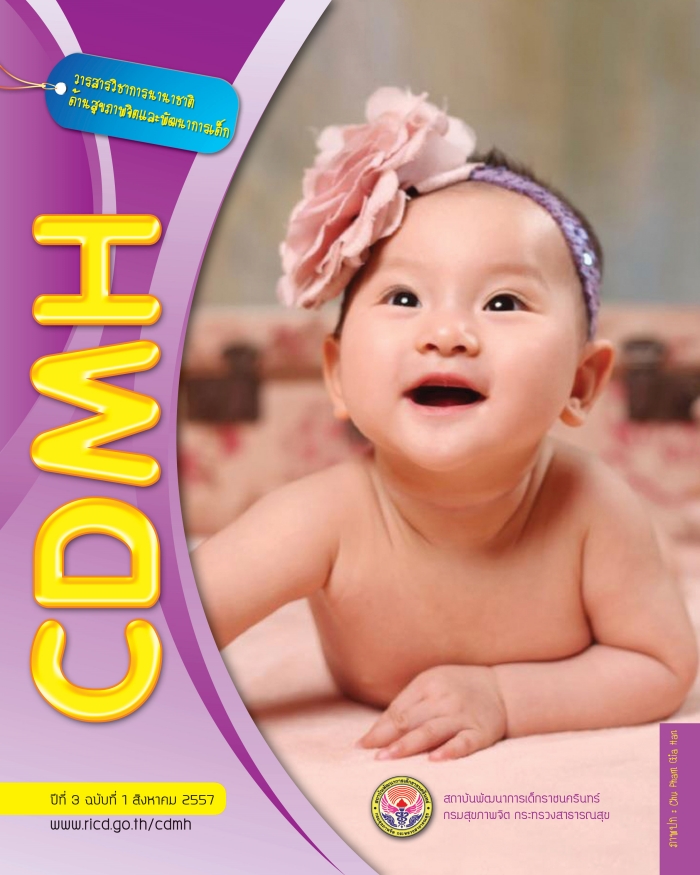The Pilot Study of Sensory Modulation Disorder Assessment Tools Using the Infant/ Toddler Symptom Checklist Aged 7 – 30 Months: Thai Version
Main Article Content
Abstract
การวิจัยครั้งนี้เป็นการวิจัยเชิงพัฒนา มีวัตถุประสงค์หลักเพื่อพัฒนาแบบรายการพฤติกรรมเด็กทารกและวัยหัดเดินช่วงอายุ 7–30 เดือน ฉบับภาษาไทย เพื่อประเมินความบกพร่องในการปรับระดับข้อมูลทางประสาทความรู ้สึก และมี
วัตถุประสงค์รองเพื่อตรวจสอบความตรงตามเนื้อหาของแบบรายการพฤติกรรม กลุ่มตัวอย่างเป็นผู้ดูแล
เด็กวัยทารกและวัยหัดเดินปกติช่วงอายุ 7–30 เดือน จำนวน 120 คน การวิจัยครั้งนี้มีกระบวนการดำเนิน
งานแบ่งเป็น 3 ระยะ ได้แก่ กระบวนการแปลกลับ กระบวนการตรวจสอบความตรงตามเนื้อหาและ
กระบวนการนำไปทดลองใช้ในผู้ปกครอง/ผู้เลี้ยงดู เพื่อนำข้อมูลมาปรับปรุงแบบรายการพฤติกรรมต่อไป
ผลการวิจัยพบว่าแบบรายการฉบับภาษาไทย ที่ผ่านการตรวจสอบความตรงตามเนื้อหาและแก้ ไข
ตามข้อเสนอแนะจากกลุ่มตัวอย่างจำานวน 7 หัวข้อหลัก หรือ 10 หัวข้อย่อย แบบรายการพฤติกรรมเด็ก
ทารก/วัยหัดเดินช่วงอายุ 7–30 เดือน ฉบับภาษาไทย ที่ได้ประกอบด้วยข้อคำาถามจำานวน 58 ข้อ แบ่งเป็น
9 หัวข้อ ได้แก่ การควบคุมพฤติกรรมเด็กทารก/วัยหัดเดิน สมาธิ การนอน การกินหรือการป้อนอาหาร การแต่งตัว การอาบน้ำและการสัมผัส การเคลื่อนไหว การฟังภาษาและเสียง การมองและการมองเห็น และความผูกพัน-อารมณ์ โดยมีการระบุความถี่ในการเกิดพฤติกรรม คือ ไม่เลย/บางครั้ง พบในปัจจุบัน และพบในอดีต แบบรายการพฤติกรรมเด็กทารก/วัยหัดเดินช่วงอายุ 7–30 เดือนฉบับภาษาไทยที่ได้นี้มี ความตรงตามเ นื้ อหาและเ หมาะสมกับบริบทของสังคมไทยและสามารถนำไปใช้ เป็นต้นแบบในการทำการศึกษาคุณสมบัติทางการวัดอื่นๆ ต่อไป เพื่อให้สามารถพัฒนาไปใช้ ในการคัดกรองปัญหาความบกพร่องของการปรับระดับการรับความรู้ สึกในเด็ก กลุ่มเสี่ยงหรือเด็กพิเศษที่เป็นเด็กเล็กหรือวัยหัดเดิน
This study was a development research. The main objective of this research was to develop
the assessment in strument for the sensory modulation problems and behaviors in children
aged 7-30 months old from the Infant/Toddler Symptom Checklist Aged 7 – 30 Months. The secondary objective was to establish content validity of the Infant/Toddler Symptom Checklist Aged 7–30 Months, Thai Version. Participants were 120 caregivers of infants and toddlers. This study was divided into 3 phases: the back-translation method, the examination of its content validity and the pilot use process was conducted with parents/caregivers of children aged 7 – 30 months in order to gain additional suggestions on the translated material. The results of this study were the Infant/Toddler Symptom Checklist Aged 7–30 Months in Thai version which was qualified by content vali dityexamination and corrected by following the suggestion of sampling after pilot use which consist of 7 subtest, 10 items. The assessment tool consisted of 58 items. These items comprised 9 subtests: self-regulation, attention, sleep, eating or feeding, dressing bathing and touch, movement, listening language and sound, looking and sight, and attachment-emotion. The frequency specification of behavioral occurrence was : never or sometimes, yes most times and past. The Infant/Toddler Symptom Checklist Aged 7–30 Months in Thai version is a prototype clinical tool which is culturally appropriate and outfitted for further psychometric property investigations and to develop the assessment tools for sensory modulation disorder in high-risk infants and toddlers.
Article Details
![]()
Creative Commons License
This work is licensed under a Creative Commons Attribution-NonCommercial-No Derivatives 4.0 International (CC BY-NC-ND 4.0)
The authors retain copyright and permit the journal the copyright of first publication
Articles, once having passed the review process and accepted for publication in the CDMH Journal, are copyrighted under the CDMH Journal, Department of Mental Health, Ministry of Public Health. Please be aware distribution of CDMH Journal content for commercial purposes without permission is expressly prohibited. However, distribution with intent to educate, advocate, or spread awareness within the general public and research communities is permitted and encouraged with the understanding that the CDMH Journal Editorial Board do not hold jurisdiction or liability for any accompanying comments, text, or information from third parties, either in favor for or against the original article’s assertions, conclusions, methodology, or content.


